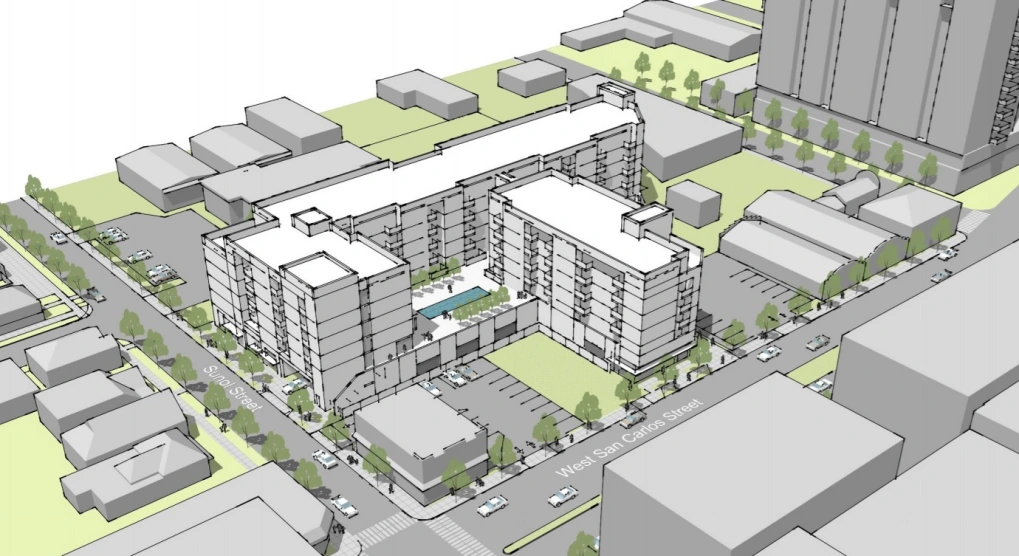Mathew Reed, SV@Home’s Director of Policy, says new affordable housing developments show Santa Clara County’s Measure A is keeping its promise, helping create homes for low-income and homeless residents in the county at “a level and rate we’ve never been able to achieve in the past.” The need for more affordable housing in the region is still great. “We need a coordinated regional approach that brings other counties into the effort so that it’s not just Santa Clara County that’s committed, but that everybody is part of the solution,” Reed said. A Bay Area-wide housing bond worth up to $20 billion could come before voters in 2024, resulting in as much as $2.1 billion for San Jose and $2.4 billion for the rest of Santa Clara County.
By Ethan Varian | Bay Area News Group | April 6, 2023, 2:07 am | Photo SGPA Architecture
Santa Clara County is finalizing plans to build three new affordable housing projects in San Jose to add more than 300 desperately needed apartments for low-income and homeless residents.
This week, the county Board of Supervisors approved spending up to $17.4 million to purchase the properties needed for the new developments. The projects include:
- The 154-unit Sunol-West San Carlos Apartments at 777 West San Carlos St. west of Highway 87 near downtown ($11.2 million)
- The 99-unit The Charles complex at 551 Keyes St. near Kelley Park ($3.2 million)
- The 60-unit Alum Rock Multifamily project at 1860 Alum Rock Ave. east of downtown between Highway 101 and Highway 680 ($3 million)
The money for the projects comes from Measure A, a $950 million affordable housing bond approved by voters in 2016. In total, up to $53.8 million in Measure A funds will go toward the developments, already approved by local officials, to help cover the land purchases and building costs.
Each project has also secured additional financing, and construction is set to begin in the coming months, officials said. The projects will be built and operated by affordable housing developers. The county will offer supportive services for formerly homeless residents.
“This is all thanks to the voters of Santa Clara County,” Supervisor Cindy Chavez, one of Measure A’s main backers, said in a statement.
In addition to the property purchases, the board approved a $4 million loan for a 99-unit affordable project at 797 S. Almaden Ave. in San Jose. The loan will use a combination of state and Measure A funding.
Mathew Reed, director of policy at the South Bay housing advocacy group SV@Home, praised Measure A for helping create homes for low-income and homeless residents in the county at “a level and rate we’ve never been able to achieve in the past.”
So far, the 10-year housing bond, funded by property taxes, has supported nearly 4,000 units and appears on track to meet its goal of helping build or preserve roughly 4,800 affordable homes by 2026.
Still, that amounts to less than 30% of the more than 25,000 low-income homes local governments in the county were supposed to approve between 2015 and 2023, according to state data. And starting in January, that state-mandated goal doubled to more than 50,000 for the current eight-year housing cycle.
With Measure A money now mostly spent, significantly more local funding will likely be needed to even approach the aggressive target, especially as state and federal housing subsidies are increasingly oversubscribed.
One proposed option is a Bay Area-wide housing bond worth up to $20 billion that could come before voters in 2024. It could mean as much as $2.1 billion for San Jose and $2.4 billion for the rest of Santa Clara County.
“We need a coordinated regional approach that brings other counties into the effort so that it’s not just Santa Clara County that’s committed, but that everybody is part of the solution,” Reed said.
In addition to raising more money, officials must also find ways to speed up the sometimes years-long city planning and permitting process, which can add crushing costs to affordable projects, Reed said. Another challenge: neighbors who oppose low-income developments over concerns ranging from traffic and pollution to the impact on their property values and of homeless people moving to their communities.
Reed pointed to controversial state laws that have stripped away local control over affordable developments in recent years as a helpful start, though he acknowledged it will likely take time before their full impact is felt.
He also commended the county’s effort to create more permanent housing for its roughly 10,000 homeless residents — but stressed that commitment must continue, even with the prospect of an impending economic slowdown.
“It doesn’t mean we’re meeting the full need,” Reed said. “Our housing market is broken and we are in a crisis.”
